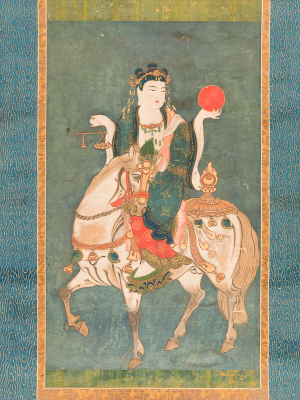Difference between revisions of "Memyō Bosatsu ( Ashvaghosha )"
(Created page with "thumb (Ashvaghosha Bodhisattva) Mounted on a Horse 15th–16th century The Bodhisattva Memyō is represented sitting regally upon a [...") |
|||
| Line 9: | Line 9: | ||
| − | The [[Bodhisattva]] Memyō is represented sitting regally upon a [[Wikipedia:White horse (mythology)|white horse]] while balancing a scale in one hand and a [[red]] disc in the other. Memyō is the [[Japanese]] reading of the [[name]] of Indian-born [[Ashvaghosha]] (circa 80–150 AD), who was not only a [[scholar]] of [[Mahayana]] [[Buddhist philosophy]], but also a renowned poet and dramatist. | + | The [[Bodhisattva]] [[Memyō]] is represented sitting regally upon a [[Wikipedia:White horse (mythology)|white horse]] while balancing a scale in one hand and a [[red]] disc in the other. [[Memyō]] is the [[Japanese]] reading of the [[name]] of Indian-born [[Ashvaghosha]] (circa 80–150 AD), who was not only a [[scholar]] of [[Mahayana]] [[Buddhist philosophy]], but also a renowned poet and dramatist. |
His [[name]] literally means "the [[sound]] (ghosha), or neighing, of a [[horse]] (ashva)," which we can assume led to the [[development]] of the association with equine [[iconography]]. The way of representing the [[bodhisattva]] is [[thought]] to have originated from depictions of a {{Wiki|folk}} [[deity]] associated with sericulture in {{Wiki|Chinese folk religion}}. | His [[name]] literally means "the [[sound]] (ghosha), or neighing, of a [[horse]] (ashva)," which we can assume led to the [[development]] of the association with equine [[iconography]]. The way of representing the [[bodhisattva]] is [[thought]] to have originated from depictions of a {{Wiki|folk}} [[deity]] associated with sericulture in {{Wiki|Chinese folk religion}}. | ||
| Line 20: | Line 20: | ||
[[Category:Buddhism]] | [[Category:Buddhism]] | ||
[[Category:Asvaghosha]] | [[Category:Asvaghosha]] | ||
| + | [[Category:Japan]] | ||
| + | |||
| + | |||
| + | [[https://www.metmuseum.org/art/collection/search/752007]] | ||
Latest revision as of 13:35, 28 July 2021
(Ashvaghosha Bodhisattva) Mounted on a Horse
15th–16th century
The Bodhisattva Memyō is represented sitting regally upon a white horse while balancing a scale in one hand and a red disc in the other. Memyō is the Japanese reading of the name of Indian-born Ashvaghosha (circa 80–150 AD), who was not only a scholar of Mahayana Buddhist philosophy, but also a renowned poet and dramatist.
His name literally means "the sound (ghosha), or neighing, of a horse (ashva)," which we can assume led to the development of the association with equine iconography. The way of representing the bodhisattva is thought to have originated from depictions of a folk deity associated with sericulture in Chinese folk religion.
This deity was later assimilated into the pantheon of Buddhist deities in Japan, where he protects those involved with silkworm raising and the production or weaving of silk, and is said to provide clothing for those in need.
Source
[[1]]
